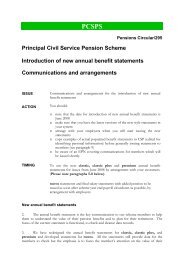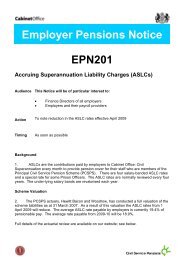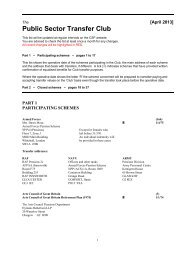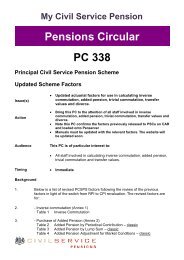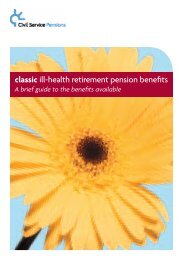Making Car Sharing and Car Clubs Work - Case ... - The Civil Service
Making Car Sharing and Car Clubs Work - Case ... - The Civil Service
Making Car Sharing and Car Clubs Work - Case ... - The Civil Service
You also want an ePaper? Increase the reach of your titles
YUMPU automatically turns print PDFs into web optimized ePapers that Google loves.
MAKING CAR SHARING AND CAR CLUBS WORKCASE STUDY SUMMARIESMarketing <strong>and</strong> promotion18.25 Most types of marketing <strong>and</strong> promotion have been used by ourcaryourcar. Hazel has hadarticles in the local press, on local <strong>and</strong> national radio as well as traditional leaflets, posters,Fundays, <strong>and</strong> launch meetings. She has attended meetings of most local groups, asking fora short slot to explain about the Club <strong>and</strong> even walks round Slaithwaite in a T-shirt with an“Ask me about <strong>Car</strong> <strong>Clubs</strong>” logo.18.26 <strong>The</strong> Club has been promoted in local schools, through assemblies <strong>and</strong> Green TransportWeek activities, harnessing “pester power”.18.27 <strong>The</strong> Club is also promoted by the local taxi operator, who puts posters in his office window<strong>and</strong> postcards promoting the scheme in the waiting area. <strong>The</strong> operator was sceptical aboutthe Club to begin with, thinking that it would compete for trade. Hazel has been able todemonstrate that car club members use local taxis more often than car owners.18.28 Members promote the scheme by word-of-mouth <strong>and</strong> this has proved to be very effective.Hazel has noticed a significant time-lag from the initial contact with potential members to thefinal signing up. One recently signed-up member was on the initial contact list drawn up bythe feasibility study team over two years ago. It is not unusual for the time-lag to be between6 months <strong>and</strong> a year. This might be because car ownership is a long-term commitment, witha high initial investment <strong>and</strong> relatively low marginal costs. <strong>The</strong>re are key points when a carowner reconsiders his or her car requirements:Existing car is getting old <strong>and</strong> becoming costly to maintain.Change in employment:oooLeading to the loss of a company car; <strong>and</strong>/orRemoving the need to commute by car; orLeading to retirement from work, <strong>and</strong> the need to restructure the householdbudget.Moving house:ooFrom an urban to a rural area, so a second car may need to be considered;<strong>and</strong>/orFrom a location that requires lots of car use to one that requires far less caruse, or vice versa.Changes in family or household circumstances leading to more or less car use (e.g.when children are born <strong>and</strong> when they leave home).18.29 At these key times, a car club can offer a realistic alternative to car ownership.18.30 <strong>The</strong>re was some discussion with members <strong>and</strong> the coordinator about the promotion of carclubs nationally <strong>and</strong> the need to put the idea into the mainstream. ourcaryourcar has done alot of work locally to promote the Club through the local press <strong>and</strong> radio. However, memberswere keen to see some kind of national promotion of car clubs <strong>and</strong> some positive placementin mainstream TV <strong>and</strong> radio. For example, the introduction of a Wheels to <strong>Work</strong> Scheme inFinal V1.1, Dec. 2004 - 100 -




